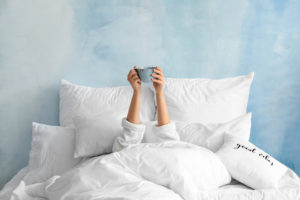
Thanks to stress, night-time device usage and poor sleep hygiene, a good night’s sleep can be hard to find. So, it’s important to do what you can to ensure a date with Morpheus (the Greek god of sleep, not the Matrix dude – though that might be cool, too). Research shows that color directly impacts our feeling of calm and how well we rest. So, the question is: What colors help you sleep?
First, What Are the Worst Color for Sleep?
Let’s start by eliminating the colors that don’t help you sleep.
Warm colors – think red lights, stop signs and hospital emergency banners – are all made to elicit an emotional response. They also energize our bodies, putting us on alert. That’s exactly what you don’t want when you’re trying to sleep.
Studies show that, if you’re looking for a calming milieu, you should avoid hues like red, yellow and orange. Instead, save these for rooms where you want to pep people up, like the kitchen, dining room or living areas.
Shift Into Neutral
Spas, hotels and resorts all have one thing in common: they’re places we go to relax and escape from the world. Many create this soothing ambience by using neutral hues. Colors drawn from nature, like gray, brown, tan, beige and green, cool our limbic systems, sending our fight-flight-freeze response off to take a nap.
So, if you’re craving a good color for sleep, steer toward a neutral. You’ll feel more positive and relaxed, both of which make it easier to get some shut eye.
Drumroll, Please: The Best Colors For Sleep
Insomnia comes in two main forms: having trouble getting to sleep and having trouble staying asleep. That means your bedroom color should do two things, help you relax and help you get a full night’s worth of Zzzs.
Think that’s a tall order for a shade of paint? Not according to science. Two studies – one 2018 study of wall color in university residence halls, and one from a 2013 survey by hotel chain, Travelodge – came up with the same results.
They found the best color for sleep is blue. But not just any blue – light to medium hues. Think: a cloudless sky or the ocean on a quiet summer morning.
The residence-hall study showed blue to be the most calming of their color list, followed closely by green. They recommended avoiding red, orange and yellow. Interestingly, women found violet hues to be relaxing while men didn’t.
That takes care of the getting-to-sleep part. But what about staying asleep?
That’s where the Travelodge survey comes in. They polled people in 2,000 homes, asking which colors most encouraged sleep. They found that people with blue bedrooms got nearly eight hours of sleep and – bonus – woke up feeling happy.
In addition to helping you relax and stay asleep, the Travelodge study also said that blue prevents nightmares.
So, if you’re looking for the best color for sleep, go Team Blue.
Looking for more bedroom paint color ideas? Browse some of our favorite projects or discover trending colors with our Color Tool. And if you’re thinking of repainting your space, let our highly qualified professional painters help you transform your home.